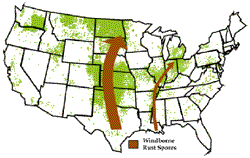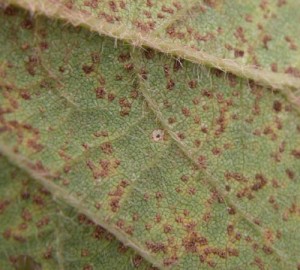Phakopsora pachyrhizi, like all rust pathogens, requires green living tissue at all times. To survive winter in the absence of a soybean crop, the soybean rust pathogen must find another living host. Thus, the soybean rust pathogen will survive in the U.S. only where freezing temperatures do not occur. Kudzu, a common perennial legume, is thought to be a potential overwintering host in these areas.
In Wisconsin, yellow sweetclover would be a possible candidate for an overwintering host of the soybean rust pathogen, except that since the foliage of this perennial host is usually killed by freezing temperatures, the rust fungus would also perish. So unless winter temperatures increase dramatically, Phakopsora pachyrhizi is not expected to survive in Wisconsin.
The absence of an overwintering source of inoculum means the soybean rust pathogen must be reintroduced to Wisconsin each growing season. Spores of the soybean rust pathogen are transported readily by air currents and can be disseminated rapidly hundreds of miles in 2 to 3 days. Weather conditions will determine when and where the spores travel from south to north.
The environment plays a major role in the incidence and severity of rust
For spore germination and infection to occur, the leaf must be wet for 6 to 8 hours. Temperatures need to be between 59° and 86° F, and humidity levels should be in the range of 75 to 80%. Under these environmental conditions, pustules are formed and spores are produced within 10 to 21 days. This can be as little as 6 to 7 days after infection when temperatures are optimal at 72 to 81° F.
Rust spores, called urediniospores, are able to penetrate the plant cells directly, rather than through natural openings or through wounds in the leaf tissue. Thus infection is relatively quick: about 9-10 days from initial infection to the next cycle of spore production. Under optimal conditions, a plant can go from the first signs of infection to severe defoliation in 1 to 2 weeks.
Hosts of Phakopsora pachyrhizi
The fungus is reported to infect 95 plant species of which most are in the legume family. Hosts of most economic importance are soybean and all types of common bean including snap bean and dry edible beans. Host range will play an important role in the epidemiology and economic importance of the soybean rust pathogen in North America.
In Wisconsin, other potential hosts are soybean, snap and kidney bean (Phaseolus vulgaris), pea (Pisum sativum), American bird’s-foot trefoil (Lotus unifoliolatus), crimson clover (Trifolium incarnatum), Korean clover (Kummerowia stipulacea), white clover (Trifolium repens), purple crownvetch (Coronilla varia), Chinese lespedeza (Lespedeza cuneata), lupine (Lupinus spp.), rattlebox (Crotalaria spp.), yellow sweetclover (Melilotus officinalis), ticktrefoil (Desmodium spp.), and winter vetch (Vicia villosa). Corn and other grain crops are not hosts.




